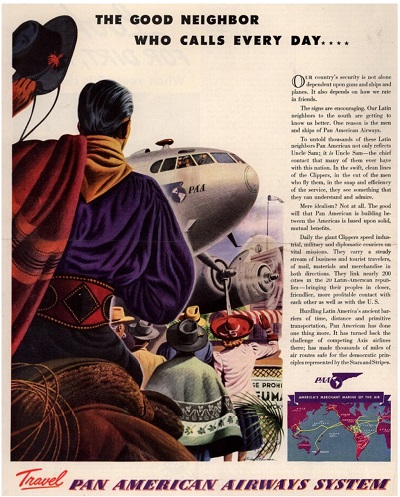Post contributed by Leah Tams, Pan Am CLIR Grant Intern.
The United States has long been an empire with colonial holdings, even since its inception. The U.S. has carried out its colonialism in many different ways, depending upon the time period and area being colonized. In the 1930s and 1940s, the “Good Neighbor Policy,” first articulated by President Franklin D. Roosevelt, became an avenue for the United States to commercially influence Latin American nations. In the spirit of the Good Neighbor Policy, the United States didn’t send hundreds of people to colonize Latin America—instead, it sent businesses to establish and extend their economic influences within the region. One of the key businesses sent to Latin America was Pan American World Airways (Pan Am).

The John W. Hartman Center’s earliest ads from Pan Am illustrate the Good Neighbor Policy in action: “Out of the Muck of the Mazatlán,” Pan Am created airfields in Latin America, which were heralded as “Another ‘Stepping Stone.’” These “stepping stones” would allow the United States to connect with various Latin American cities and civilizations, thus extending U.S. influence southward. Other early advertisements were even more overt in their reference to the policy, proclaiming that Pan Am was indeed “The Good Neighbor Who Calls Every Day” who would create meaningful—and influential—political and economic contact between both regions. As historian Jennifer Van Vleck argues, “the development of commercial aviation did important work to make the U.S. presence in Latin America appear more benign while also bringing the region within closer reach of Washington and Wall Street.”[1]
Once Pan Am had an established presence in Latin America, it was fairly simple to begin advertising the wondrous destinations available—particularly because Pan Am (or, more accurately, Panagra, as the joint venture in South America was known) presented the region as an almost-undiscovered land. Ads from the late 1940s assured travelers that they would “travel in the intrepid footsteps of Pizzaro [sic],” in a paradise “spangled with the glories of past centuries.”[2] These intimations of Francisco Pizarro—the Spanish conquistador who invaded Panama and Peru—and other overt references to the colonialist efforts of Pan Am, which injected U.S. influence and culture into South America, would continue for decades.

In 1962, the J. Walter Thompson Company (JWT), Pan Am’s principal advertiser, launched a campaign for Panagra that touted the “Charms of South America” to potential travelers. To its travel agents, JWT called this effort the “Greatest Campaign Since Pizarro!” Other Panagra advertisements from the 1960s celebrate Pizarro’s lasting impact upon Lima, Peru, stating that “He laid out the city’s streets, the government buildings, the cathedral, just where you see them today.” With these references to and celebrations of Pizarro, it seems as though Pan Am is encouraging its travelers to once again conquer and colonize Latin America—in fact, Panagra ads from 1965 invite travelers to “Capture the city Pizarro couldn’t!” (referring to Machu Picchu in Peru) and underscore the flippant imperialism of the U.S.

To be sure, contemporary advertisements for Pan Am’s flights to Europe portray the continent and its destinations as commodities, most often as dollar amounts. But where European cities and regions are reduced a monetary figure, they are never reduced to places that can be conquered, subdued, or gifted civilization the way that Latin America is. In Latin America, it seems that Pan Am found the perfect candidate for profit and U.S. imperialism, veiled in the thin language of adventure.
[1] Jennifer Van Vleck, Empire of the Air: Aviation and the American Ascendancy (Cambridge, MA: Harvard University Press, 2013), 54.
[2] “Panagra Vacation,” 1947, https://repository.duke.edu/dc/adaccess/T1593.


